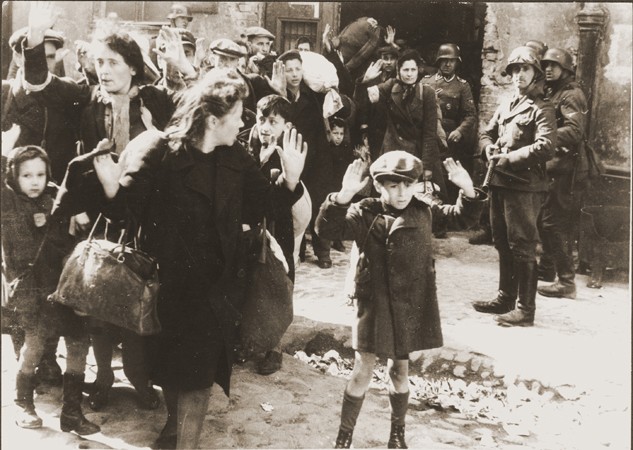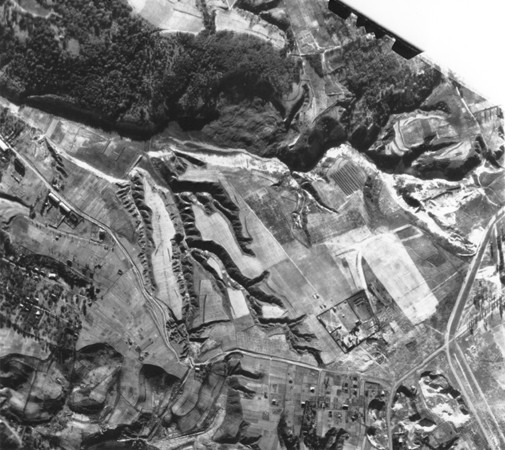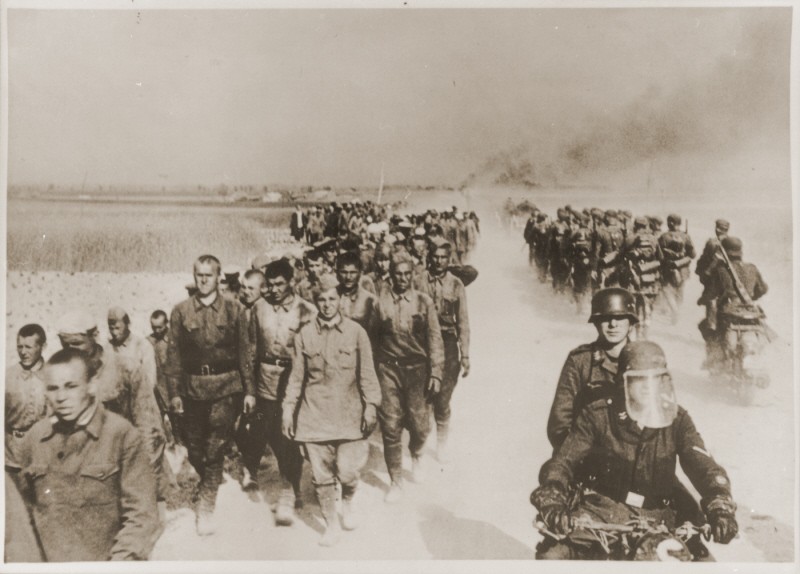
The German Military and the Holocaust
The German military participated in many aspects of the Holocaust: supporting Adolf Hitler, using forced labor, and murdering Jews and other groups targeted by the Nazis.
Key Facts
-
1
Members of the German military murdered or were complicit in the murder of Jews as well as people with disabilities, Roma (Gypsies), Soviet prisoners of war, and eastern European civilians.
-
2
The German military knowingly supported the Einsatzgruppen, which worked in the rear of the German lines in the east as mobile killing units.
-
3
The war crimes of the German High Command formed the basis for Case #12 of the Subsequent Nuremberg Proceedings, the High Command Trial.
German Military Participation in the Holocaust
During World War II, the German military helped fulfill Nazism's racial, political, and territorial ambitions. Long after the war, a myth persisted claiming the German military (or Wehrmacht) was not involved in the Holocaust and other crimes associated with Nazi genocidal policy. This belief is untrue. The German military participated in many aspects of the Holocaust: in supporting Hitler, in the use of forced labor, and in the mass murder of Jews and other groups targeted by the Nazis.
The military’s complicity extended not only to the generals and upper leadership but also to the rank and file. In addition, the war and genocidal policy were inextricably linked. The German army (or Heer) was the most complicit as a result of being on the ground in Germany’s eastern campaigns, but all branches participated.
The Nazification of the German Military
The often conservative leadership of the German military initially saw Adolf Hitler as a radical and as a political upstart. They did not support his attempted coup, the 1923 Beer Hall Putsch. They fired on Hitler and his fellow insurrectionists rather than joining them.
However, the SA (Sturmabteilung, or Storm Troopers), under the control of Ernst Röhm, posed a threat to the army. Röhm wanted the SA to replace the professional military as a people’s army. Consequently, in 1934, military leaders agreed to support Hitler’s undermining of the SA’s power and the elimination of much of its leadership in exchange for a guarantee of their status as the sole national military organization. The military did not intervene on June 30, 1934, when the SS murdered Röhm and many of the SA’s top officials. They also murdered other old enemies with whom the regime had a score to settle, such as General Kurt von Schleicher, who had preceded Hitler as Chancellor. This purge became known as the Night of the Long Knives.
Two months later, the military changed its oath of service. In the new version, soldiers swore “unconditional obedience” to the Führer personally rather than to the German constitution. In 1935, in accordance with Nazi racial law, the military prohibited Jews from joining its ranks. Those already serving were dismissed. In 1938, Hitler assumed the title of supreme commander of the entire German military. All of these moves helped solidify the union between Hitler and his generals.
Common Ground between the Military and the Nazi Leadership
The highest-ranking officers were aristocrats and upper-middle class professions. While they still did not always agree with Hitler, they found a common ground that allowed them to partner with him.
First, Hitler succeeded in rebuilding the German military after the humiliating reductions of the Versailles Treaty after World War I. Second, he promised the opportunity to fight their enemies in France and the Bolshevist Soviet Union. Finally, many generals received systematic bribes from Hitler in the form of extra pay, grants, and even gifts of lands and estates.
Meanwhile, as the German army increased in size, it also became more politically extreme. While senior officers may not have always been committed Nazis, younger soldiers and officers entered the service having come of age under the constant propaganda of the Third Reich. Building upon this, the Wehrmacht continued to ideologically indoctrinate German troops. Army newspapers and bulletins, films, and lectures by “educational officers” spread racist and antisemitic propaganda and emphasized that Germany was fighting a defensive war against “Judeo-Bolsheviks” and “plutocratic” conspirators eager to destroy European civilization and enslave the German people. While it is not possible to generalize completely about an organization of 17 million men, increasingly the German army became willing to support the Nazi leadership’s aggressive wars and genocidal policies.
The War of Annihilation in the Soviet Union
The criminality and complicity of the army in the Holocaust and other Nazi crimes escalated most clearly during the invasion of the Soviet Union. Well before the attack, the High Command issued three “Criminal Orders” which explicitly rejected the laws of war and encouraged soldiers to commit atrocities.
The first, the “Jurisdiction Order,” stated that soldiers would not be prosecuted for crimes in the Soviet Union as they would elsewhere in Europe.
Second, soldiers received the “Guidelines for the Behavior of the Troops” which instructed that “this war demands ruthless and aggressive action against Bolshevik agitators, snipers, saboteurs, and Jews, and tireless elimination of any active or passive resistance.” Thus, Jews became almost immediately a target for the German army.
Finally, the Commissar Order directed that all captured Soviet political commissars be immediately executed. Political commissars were Soviet Communist Party officials who oversaw its military units and reported directly to party leaders. The order was in direct violation of the treaties Germany had signed. Nevertheless, 90 percent of German units carried it out.
A flurry of additional antisemitic, anti-Bolshevik, and brutal orders accompanied these three orders, creating a culture which condoned and encouraged war crimes. The war in the Soviet Union would not be a conventional war, but instead would be a war of racial annihilation.
Complicity with the Einsatzgruppen
The German army first encountered the Einsatzgruppen in Poland in 1939, to the consternation of some generals. For example in February 1940, Johannes Blaskowitz, German military commander for the eastern territories, complained about the SS policy of slaughtering some 10,000 Jews and Poles, which he believed would hurt Germany. He argued that such actions strengthened enemy propaganda about German atrocities, united Jews and Poles against Germany, weakened the respect of the Wehrmacht, and led to the spread of mass depravity among Germans. He urged that those units found guilty of carrying out such murderous actions be held accountable by military authorities.
To prevent such criticism from erupting following the invasion of the Soviet Union (Operation Barbarossa), SS and army leaders crafted a detailed agreement beforehand under which the army would provide logistical support to the Einsatzgruppen as they carried out the systematic mass murder of 1.5-2 million Jewish men, women, and children throughout the East. The army was fully aware of the activities of these units through liaison officers and its own reports.

Beyond simple logistical support, the army often was directly involved in the decision-making and implementation of mass murder. Following the explosion of bombs planted by Soviet agents in a number of public buildings in Kiev, the German military commander of the city met with SS officials to arrange the killing of Kiev's Jews. A Wehrmacht propaganda company printed and posted several thousand posters, demanding that Jews report for "resettlement." On September 29-30, 1941, SS and German police units and their auxiliaries, under the jurisdiction of Einsatzgruppe C, murdered the Jewish population of Kiev at Babi Yar, a ravine northwest of the city. This was one of the largest mass murders at an individual location during World War II. According to reports by the Einsatzgruppe to headquarters, 33,771 Jews were massacred in two days.
Elsewhere in the Soviet Union, the German army itself actively carried out mass shootings of Jews, often under the cover of the anti-partisan war. The assistance of the army was necessary as the Einsatzgruppen were simply too short-handed to carry out the massive number of killings required. Non-Jewis were also among the victims in many killings, including Roma (Gypsies), patients with disabilities, and Soviet commissars. In addition, as military units were often the first in newly occupied regions, many were responsible for establishing ghettos and implementing anti-Jewish regulations such as forced labor and the wearing of the yellow star.
Soviet Prisoner of War Policy

In addition to its complicity in the Holocaust, the German army bears the major responsibility for the mass death of captured Soviet prisoners of war (POWs). Due to its initial military success, the German army captured millions of Soviet soldiers. In only eight months, 2 million Soviet POWs had died in German custody; this is eight times the number of American combat casualties for the entire war. More Soviet POWs died each day in the summer and fall of 1941 than British and American POWs died during the entire war.
These deaths were not the result of poor planning and insufficient resources. They resulted from intentional policy, decided upon before the invasion. These POWs were given no shelter from the heat or cold, insufficient food, and little medical care. In all, 3.3 million Soviet soldiers are estimated to have died.
Army units also participated in separating Jewish POWs and commissars in the camps so that they could be murdered.
Military Participation in the Economy and Forced Labor
Beyond its role in assisting in and carrying out the direct murder of Jews and others, the German military employed and benefited from the theft of Jewish property and the use of forced labor at all levels. For example, in the winter of 1941, Jews across eastern Europe were forced to surrender their warm clothing to be used by unprepared German soldiers at the front. Also, hair shaved from Jews murdered in the killing centers was used by the German navy to line submariners’ boots and to create felt.
From the smallest unit up, the army used Jewish slave labor to further the war effort. In the field, Jews were forced to perform a variety of tasks from digging anti-tank ditches to repairing vehicles to serving as human minesweepers. In German concentration camps, such as Dora-Mittelbau, and in the ghettos in German-occupied Poland, Jews worked for the armaments industry. They worked on everything from uniforms to artillery shells to the infamous V2 rockets. At the Dora site, thousands of concentration camp prisoners died digging massive underground tunnels by hand to conceal the factory from Allied air attacks.
Military Justice in Wartime
Following the outbreak of war, the Nazi regime stiffened up policies, laws, and penalties for civilians and military personnel accused of undermining morale, sabotage, or espionage. Hitler believed that draconian measures would prevent Germany from experiencing another November 1918, when Imperial Germany signed the armistice ending World War I. The Wehrmacht dramatically increased the number of military courts responsible for trying such cases from less than 300 in December 1939 to almost 700 in 1944. Scholars estimate that German military courts passed some 33,000 death sentences against soldiers and civilians. In World War I, the German military issued 150 death sentences, of which it carried out only 48 executions.
As Nazi Germany headed towards defeat the number of convictions and death sentences increased. On Hitler’s orders drum-head courts, special courts operating in the field, were established in February 1945. Composed of Nazi officials, police, and/or military personnel, these courts could issue only two verdicts, guilty or not guilty. Guilty verdicts were punished with the death penalty. Deserters, officials who offered to surrender their towns to the advancing Allied armies, or civilians who criticized Nazi measures often were executed by hanging or shooting.
Resistance
Not all military personnel agreed with Nazi policy. Some protested while others actively rescued Jews. While these honorable individuals constituted a statistically small minority, they demonstrated that it was possible to resist and help Jews, even in the disciplined and authoritarian army structure.
In addition, a few high-ranking German officers participated in the unsuccessful plot to assassinate Hitler on July 20, 1944. Yet this effort must be seen as an attempt to regain control of the war effort before Germany was destroyed rather than as an attempt to halt the Holocaust. Indeed, some of the conspirators themselves were deeply implicated in the army’s complicity in the Holocaust.
The “Clean Wehrmacht” Myth
Almost immediately after the end of the war, the myth arose that the German military had merely fought their enemies, including the Soviets, in a conventional war and was not involved in the Holocaust or other genocidal policies. This legend began at Nuremberg where the SS was deemed a criminal organization, but the military was not. Only the members of the High Command were tried as war criminals, in Case #12 of the Subsequent Nuremberg Proceedings.
In addition, the United States, seeking expertise and advice to fight new Cold War enemies in the Soviet Union, brought many German generals and officers to the United States. These men wrote highly sanitized memoirs which intentionally concealed the deep complicity of the German military in the Holocaust.
Further, legal prosecution of the military was almost non-existent in postwar Germany. Even as scholars began dismantling the myth, it remained a widely held belief among the German (and American) public.
One of the first attacks in the public sphere on the myth of the “Clean Wehrmacht” occurred in 1995 with the War of Annihilation: Crimes of the Wehrmacht 1941 to 1944 exhibition, which premiered in Hamburg, Germany, in March 1995. The exhibition, which eventually traveled to 33 German and Austrian cities, demonstrated in stark detail how deeply the military was involved in the Holocaust. A second and updated exhibition, Crimes of the German Wehrmacht: Dimensions of a War of Annihilation 1941-1944, followed in 2001.
Ongoing research shows just how willingly and profoundly the military participated in the Holocaust. This research continues to dismantle the myth of the “Clean Wehrmacht.”
Footnotes
-
Footnote reference1.
Felix Römer, "The Wehrmacht in the War of Ideologies: The Army and Hitler’s Criminal Orders on the Eastern Front," in Nazi Policy on the Eastern Front, 1941: Total War, Genocide, and Radicalization, ed. Alex J. Kay, Jeff Rutherford, and David Stahel (Rochester, NY: University of Rochester Press, 2012), 152-53.
Critical Thinking Questions
- How did the role of the German military change during 1933-1945? Why?
- How were the orders for the eastern front different than previous orders for campaigns in the west? How do you account for this difference?
- Have military codes and the Laws of Armed Conflict changed since World War II? How and why?

